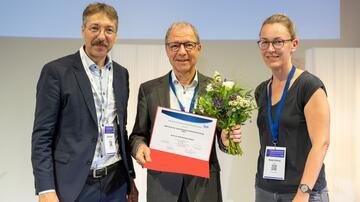Microscopy of hepatitis viruses
A Microscopy Unit was established at the Heidelberg Partner Site for research groups from the research field “Hepatitis” and other research fields including “Emerging Infections” in particular. The Microscopy Unit enables research groups to conduct their analyses and investigate live cells and tissues infected with hepatitis viruses and other pathogenic viruses at the required biosafety levels 2 and 3. Using the imaging methods provided for at this unit, researchers have been able to decode the mechanisms of action of different antiviral substances and have also been able to characterise the various interactions between viruses and host cells.
In addition, electron and correlative microscopy methods are available for use in joint projects. Furthermore, training in light and electron microscopy is provided.
Hepatitis viruses that are pathogenic for humans, such as the hepatitis B virus (HBV) and the hepatitis C virus (HCV), may only be investigated in biosafety level 3 laboratories. Biosafety level 3 laboratories are only available on a limited basis due to the elaborate technical requirements, and advanced light microscopes are rarely available within these laboratories as they are very costly. This presents a major obstacle to research as the viruses are obligate intracellular parasites and can consequently only be studied in live cells.
See more about the Hepatitis C virus life cycle
It is for this reason, that Professor Bartenschlager established the Microscopy Unit within his department to enable the investigation of cells infected with hepatitis and other viruses at high biosafety levels. This unit provides the opportunity to conduct microscopic analysis of live cells, for example, to study the dynamics of an infection or the efficacy of antiviral drugs. This unit has enabled scientists to demonstrate that daclatasvir and other NS5A inhibitors block hepatitis C virus replication by preventing the virus from building replication factories.
The Microscopy Unit also enables researchers from joint projects to carry out analysis on cells or tissues that are infected with other viruses. For example, the structure of Zika virus’ replication factories was deciphered in close collaboration with the research field Emerging Infections, and it was demonstrated that inhibitors of the cytoskeleton prevent the replication of the virus in human neuronal cells. Thanks to research carried out under numerous joint projects conducted at this Microscopy Unit, the mechanism of action of an HCV inhibitor was deciphered and a target site for the human norovirus identified. The results were mainly achieved by means of correlative microscopy, which is a combination of light and electron microscopy.
An important feature of this Microscopy Unit is that it provides training in the use of light and electron microscopy. The training is offered in close collaboration with the HIV Microscopy Unit and includes training on the use of both established and new microscopy methods as well as analysis procedures and quantification of light microscope images.





